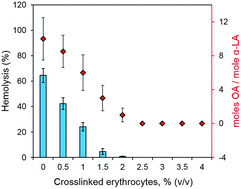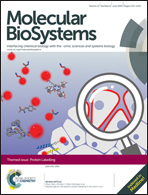Behaviour of oleic acid-depleted bovine alpha-lactalbumin made LEthal to tumor cells (BAMLET)†
Abstract
Oleic acid (OA) complexes of human alpha-lactalbumin (α-LA) and several other proteins are effective in the killing of a variety of tumor cells. While debate on whether the key component of the complexes is the OA or protein continues, studies probing the mechanism of action of the complexes at the tumor cell surface or in the cell interior assume the action of a molecule in the form of an undissociated complex. Recent evidence however suggests that OA complexes of protein are stripped of bound OA on interaction with artificial or natural membranes before entering the cell. Properties of BAMLET stripped of its OA by exposure to erythrocytes (ET-BAMLET) were investigated in the study. ET-BAMLET resembled α-LA in its inability to induce hemolysis of erythrocytes and behaviour in a gel filtration column. Spectroscopy techniques-fluorescence, far- and near UV CD as well as calorimetry and proteolysis however suggest the molecule to be different both from native α-LA and the apo form. Remarkably, unlike native α-LA and apo-α-LA, ET-BAMLET binds OA and turns hemolytic by simple mixing with the fatty acid around neutral pH. Since BAMLET/HAMLET incubated cells take up large amounts of OA, the study suggests the possibility of ET-BAMLET combining with OA and reforming the complex inside the cells.

- This article is part of the themed collection: Chemical Biology in Molecular BioSystems

 Please wait while we load your content...
Please wait while we load your content...